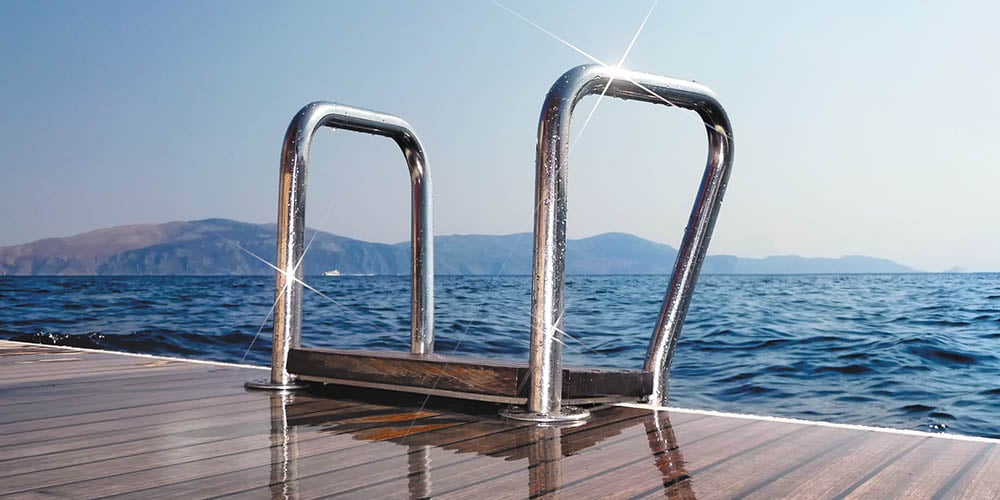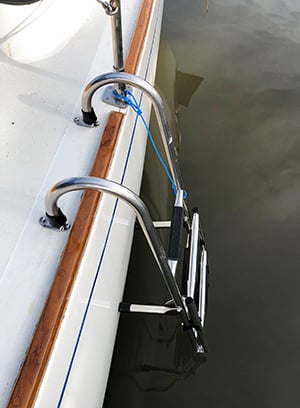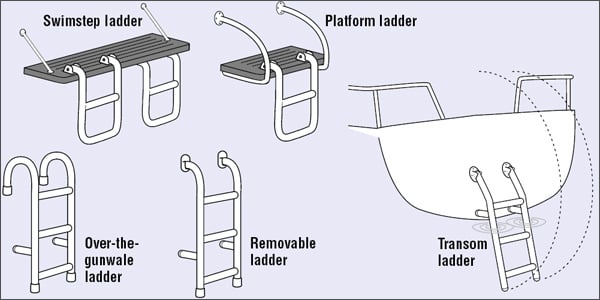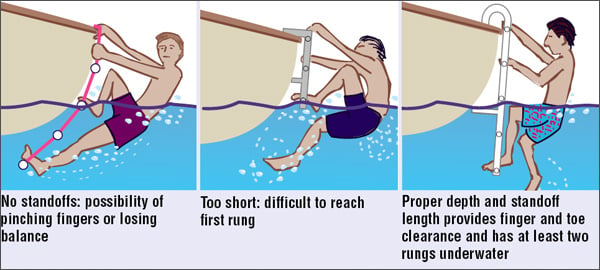
What Boarding Ladders Do
Boarding ladders allow boaters to get in and out of the water from the deck or swim step of a boat and aid in boarding from a dinghy. Although they can sometimes be used to help in the retrieval of a crew member who has fallen overboard, they are typically of little or no use in rough seas. We'll help you choose the right one for your boat.

West Marine 5-Step Gunwale-Mount Boarding ladder installed on the author's boat.
How Boarding Ladders Work
Boat ladders must extend below the level of the water to be effective. We like ladders with at least 2-3 rungs below the surface, which means they must either fold or be removed when underway.
Common Ladder Types
- Over-the-gunwale ladders are commonly used for runabouts and small sailboats. These have hooks that vary in width to match the width of the gunwale.
- Swim step ladders hang down from powerboat swim steps and usually retract underneath or fold up on top of the step. Since the swim step is so much lower than the side of the boat, these ladders generally need only 1-3 steps.
- Platform ladders create a mini-swim step on one side of the outboard or outdrive. These come with a platform and side rails.
- Transom ladders on sailboats hinge up and down and generally match the appearance of the pushpit.
- Removable ladders fit in brackets bolted to the hull or deck. The brackets have keyhole slots that hold the ladder securely, yet allow it to be removed quickly for storage.
Many ladders fold in half so they can be left in place without dragging in the water. They can be used while folded when boarding from a dinghy and extended when swimming. They are also easier to stow. Rope ladders are flexible, collapsible and lightweight, but they're not ideal as a primary ladder because their flexibility makes them difficult to climb. Try in calm water before you rely on them as your sole reboarding method.

What to Look for When Choosing a Boarding Ladder
Comfort and Security
We like broad, nonskid treads, since 1" stainless tubing is remarkably painful under bare feet. We also like ladders that stand off away from the side of the hull, because they provide finger and toe clearance. Side rails that extend above deck level provide a handy place to grab.
Construction
Ladders are made from noncorroding materials like stainless steel, aluminum and plastic. Aluminum is lighter and less expensive, while stainless-steel looks better and is stronger. Plastic treads are fine and are quite comfortable.
Where to Mount Your Boarding Ladder
Ladders should be mounted so that the steps extend far enough into the water to make climbing aboard as easy as possible and at a spot that's convenient for boarding. For example, stern ladders are quite common on sailboats, but this is frequently where the motion of the boat is the greatest. On sailboats with a fixed pushpit, a better place may be on the side, near the cockpit, where the lifeline gate is located.

Installing a Boarding Ladder
A reliable boarding ladder is an important component of your boat's water fun and playtime equipment. It's also a key crew overboard device, at least in calm water conditions. As an owner of an offshore racing sailboat, I wanted a boarding ladder that could be used with my Lifesling 2 in case someone went overboard. The Lifesling2 is a great device for throwing to a person in the water, but getting them back aboard requires either a hoisting tackle, a sturdy boarding ladder or both.

The bottom of the ladder is just above the waterline, so it stays clean. I have added a keeper line to prevent loss of the ladder.
My first choice was dictated by affordability, and I chose the Sea-Dog 5-Step Boarding Ladder. Its virtues of light weight, easy storage and cost were overwhelmed by the product's deficiencies. It was extremely unstable and provided zero confidence as I tried to climb out of a kayak and onto the ladder.
Eventually I bought the West Marine 5-Step Gunwale-Mount Boarding Ladder shown in the photos on this page. It is mounted in the gated area of my Cal 40's lifelines. I purchased a second set of the mounting sockets that fit these ladders, so the ladder can be deployed on either side of the boat. The freeboard of my boat (waterline to deck) is about 36 inches. When my ladder is folded, the bottom is about 1-1/2 inches above the water's surface. Flip it down, and two steps are under water. Notice also my blue Amsteel keeper lanyard. It is secured around the base of the stanchion, just in case the ladder should somehow get loose from the mounting clips.